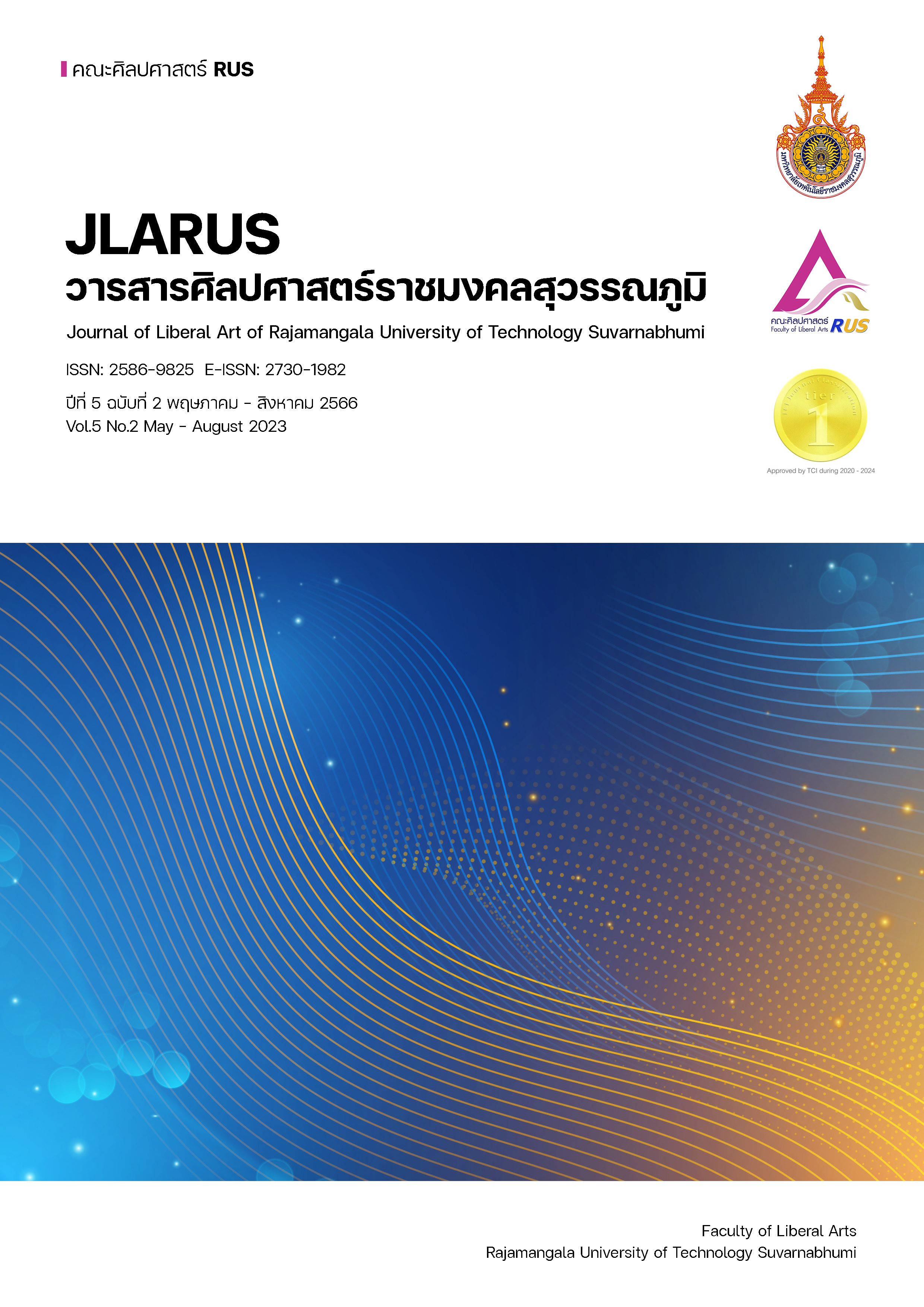TOURISM NETWORK MODEL OF TOEI PANAN HANDICRAFT COMMUNITY-BASED TOURISM, LOWER U-TAPAO CANAL WATERSHED, BANG KLAM DISTRICT, SONGKHLA PROVINCE
Main Article Content
Abstract
The objectives of this article were to: 1) study the components of Toei Panan handicrafts community-based tourism network, Lower U-Tapao Canal Watershed, Bang Klam District, Songkhla Province, and 2) study the tourism network model of Toei Panan handicraft community-based tourism, Lower U-Tapao Canal Watershed, Bang Klam District, Songkhla Province. The study was a qualitative research. In-depth interview was used to collect data from 15 respondents. The respondents were the representatives of Songkhla Provincial Office of Tourism and Sports, the representatives of local government organizations, the representatives of Songkhla Community Tourism Association, the representatives of Tourism Council of Songkhla, and the community leaders and members of the Toei Panan weaving group.
The results showed that 1. Participation of the Toei Panan handicraft community-based tourism network, Lower U-Tapao Canal Watershed, Bang Klam District, Songkhla Province were:
1) Toei Panan handicraft community-based tourism network, Lower U-Tapao Canal Watershed, Bang Klam District, Songkhla Province were: 1) Government organizations/associations played important roles in supporting the community-based tourism management, public relations, and tourism plans and tourism promotion, 2) Academic sections played roles in transferring management knowledge of Toei Panan Handicraft learning center, making Toei Panan Handicraft learning-based tourism center, designing tourism programs and activities, and training community members, 3) Local administrative organizations played roles in tourism promotion, participated in community tourism planning meetings in order to determine tourism patterns and develop community-based tourism to match the community contexts, and 4) The community members participated in the conservation of local resources as tourism resources. and 2. The tourism network model of Toei Panan handicraft community-based tourism network, Lower U-Tapao Canal Watershed, Bang Klam District, Songkhla Province can be divided into internal and external networks. Community leaders are the key person of network coordination process.
Article Details

This work is licensed under a Creative Commons Attribution-NonCommercial-NoDerivatives 4.0 International License.
References
กรกนก เกิดสังข์. (2560). การพัฒนาการท่องเที่ยวอย่างยั่งยืนเชิงกลยุทธ์: กรณีศึกษา ตำบลบางใบไม้อำเภอเมือง จังหวัดสุราษฎร์ธานี. วารสารราชภัฏสุราษฎร์ธานี, 4(2), 231-249.
จิราภรณ์ แก้วมณี. (2557). แนวทางการจัดการการท่องเที่ยวโดยชุมชนตามปรัชญาของเศรษฐกิจพอเพียง ชุมชนบ้านหัวเขาจีน (วิทยานิพนธ์ปริญญาศึกษาศาสตร์มหาบัณฑิต). กรุงเทพมหานคร: มหาวิทยาลัยศิลปากร.
ทิพย์สุวรรณ แซลี้. (2561). ศึกษารูปแบบเครือข่ายการจัดการท่องเที่ยวโดยชุมชนที่เหมาะสมของชุมชนบ้านอาลึ และชุมชนบ้านอ้อมแก้ว จังหวัดสุรินทร์ (วิทยานิพนธ์มหาบัณฑิตไม่มีการตีพิมพ์). อุบลราชธานี: มหาวิทยาลัยอุบลราชธานี.
เทิดชาย ช่วยบำรุง. (2552). บทบาทขององค์กรปกครองส่วนท้องถิ่นกับการพัฒนาการท่องเที่ยวอย่างยั่งยืนบนฐานแนวคิดเศรษฐกิจพอเพียง. กรุงเทพมหานคร: สำนักพิมพ์คณะรัฐมนตรีและราชกิจจานุเบกษา.
ปริวรรต สมนึก. (2561). การพัฒนารูปแบบเครือข่ายการจัดการท่องเที่ยวโดยชุมชนระหว่างชุมชนบ้านทรายมูล และชุมชนบ้านโพธิ์ศรี อำเภอพิบูลมังสาหาร จังหวัดอุบลราชธานี. วารสารศิลปศาสตร์ มหาวิทยาลัยอุบลราชธานี, 14(1), 70-112.
พิมพิกา นวนจา และศิริพงษ์ ลดาวัลย์ ณ อยุธยา. (2563). ภาคีเครือข่ายการจัดการท่องเที่ยวของหมู่บ้านแม่กำปอง ตำบลห้วยแก้ว อำเภอแม่อ่อน จังหวัดเชียงใหม่. วารสารรัฐศาสตร์และรัฐประศาสนศาสตร์, 11(2), 29-54.
วิสิทธิ์ศักดิ์ ชัยเกิด. (2559). การพัฒนารูปแบบการจัดการเครือข่ายความร่วมมือเพื่อการยกระดับคุณภาพการศึกษาของโรงเรียนประถมศึกษาสังกัดสำนักงานคณะกรรมการการศึกษา ขั้นพื้นฐาน (ปริญญานิพนธ์ปริญญาดุษฎีบัณฑิต). มหาสารคาม: มหาวิทยาลัยมหาสารคาม.
วีระพล ทองมา. (2561). การท่องเที่ยวโดยชุมชน (Community Based Tourism: CBT) สำหรับการพัฒนา คุณภาพชีวิตของชุมชนในเขตที่ดินป่าไม้. กรุงเทพมหานคร: กรมอุทยานแห่งชาติสัตว์ป่าและพันธุ์พืช. ค้นเมื่อวันที่ 9 มิถุนายน 2566, จาก www.dnp.go.th/fca16/file/i49xy4ghqzsh3j1.doc.
สถาบันการท่องเที่ยวโดยชุมชน. (2561). การท่องเที่ยวโดยชุมชน. ค้นเมื่อวันที่ 9 มิถุนายน 2566, จากhttp://www.cbt-i.or.th/.
สถาบันพัฒนาองค์กรชุมชน. (2560). พระราชบัญญัติสภาองค์กรชุมชน พ.ศ. 2551. ค้นเมื่อวันที่ 9 มิถุนายน 2566, จาก http://www.codior.th/index.php.
สมศักดิ์ สามัคคีธรรม. (2562). การจัดการคลัสเตอร์การท่องเที่ยวโดยชุมชนที่สอดคล้องกับปรัชญาของเศรษฐกิจพอเพียง. วารสารการเมืองการบริหารและกฎหมาย, 11(1), 95-115.
สำนักพัฒนาการท่องเที่ยว. (2550). คู่มือเครือข่ายการท่องเที่ยวโดยชุมชน. กรุงเทพมหานคร: บริษัทศรีเมืองการพิมพ์ จำกัด.
สุดถนอม ตันเจริญ. (2560). การจัดการการท่องเที่ยวโดยชุมชนกับการพัฒนาการท่องเที่ยวอย่างยั่งยืนของชุมชนบางขันแตก จังหวัดสมุทรสงคราม. วารสารวิชาการการท่องเที่ยวไทยนานาชาติ, 13(2), 1-24.
อนุชา ม่วงใหญ่. (2559). แนวทางการพัฒนาเพื่อเสริมสร้างศักยภาพชุมชนและท้องถิ่น “ในศตวรรษที่ 21”. วารสารวิชาการมหาวิทยาลัยอิสเทิร์นเอเชีย ฉบับสังคมศาสตร์และมนุษยศาสตร์, 6(3), 12-26.
อรรถกร จัตุกูล. (2560). บทบาทของชุมชนในท้องถิ่นต่อการพัฒนาตลาดการท่องเที่ยว จังหวัดบุรีรัมย์ กรณีศึกษาชุมชนวนอุทยานเขากระโดง (รายงานการวิจัย). บุรีรัมย์: มหาวิทยาลัยราชภัฏบุรีรัมย์.


